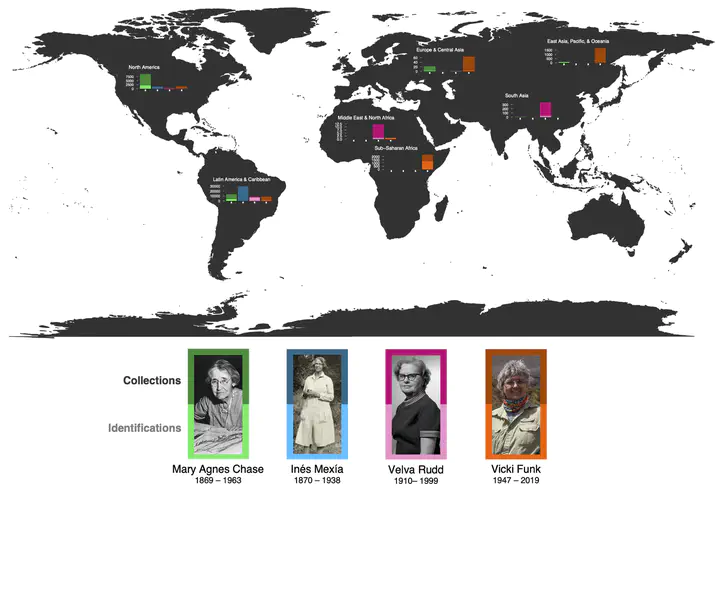 World map showing geographic distributions of specimen attributions binned into world regions by botanists Mary Agnes Chase, Velva Rudd, Cleofé Calderón, and Vicki Funk. For each researcher, the darker shade indicates collections, and the lighter shade indicates identifications. Photo of Funk taken by M. Bonifacino and published in Susanna et al. (2020). Other photos are from the Smithsonian Institution.
World map showing geographic distributions of specimen attributions binned into world regions by botanists Mary Agnes Chase, Velva Rudd, Cleofé Calderón, and Vicki Funk. For each researcher, the darker shade indicates collections, and the lighter shade indicates identifications. Photo of Funk taken by M. Bonifacino and published in Susanna et al. (2020). Other photos are from the Smithsonian Institution.Abstract
Premise of research. Natural history collections are essential resources for taxonomy, systematics, and ecological and climate change research. Mass digitization of these collections provides the opportunity to study broad biological patterns among specimens and their associated metadata at a scale that was previously impossible. The specimen metadata can also be used to study the contributions of the people that collected and identified these specimens. A proper accounting of these contributions impacts our understanding of the history of these collections and who played a role in their growth.
Methodology. Here, we provide an assessment of the scientific contributions of past women in science at the Smithsonian Institution, focusing on their specimen collections and identifications. We evaluate natural history specimen collections records available from the Global Biodiversity Information Facility and Smithsonian annual reports, volumes dating to the founding of the Smithsonian in 1846.
Pivotal results. We identify 40 women with specimen collections or identifications, with a total of more than 120,000 total specimens attributed to them. In cases where specimens are not yet digitized, we are able to learn more about the women’s contributions using annual reports, which provide a richer picture of their work at the Smithsonian. This work relies on collaboration as well as deep institutional knowledge. We also release a semantic search application, which allows users to search the Smithsonian annual reports.
Conclusions. Collections records are a rich resource, but there are significant barriers to accurate specimen attribution, which disproportionately affect women collectors and determiners. We propose ways that we might document these problems at scale and remedy cases of misattribution in digital repositories of record.
